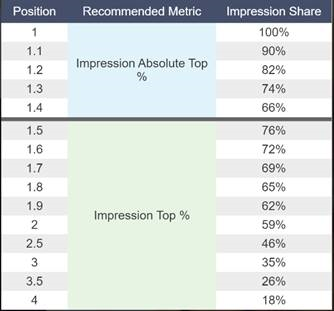As of 30th September, Google’s ‘average position’ metric was retired to make way for ‘prominence metrics’. This change may be viewed as a serious concern for advertisers but Marin Software’s Head of Marketing, Wesley MacLaggan, showcases how it is possible to transition from one metric to the other seamlessly and without impacting success.
In advertising, there are several key questions that are always bandied around: how are our ads performing? What’s the ROI like? Are we increasing brand awareness?
Marketers using Google Ads have been comfortable responding to these questions, often relying on the ‘average position’ metric but as of September 30th that metric was fully retired to make way for ‘prominence metrics’, made up of Impression Share and Impression Rate, which have been being phased in since November 2018.
If this development fills you with panic and like the vast majority of people on the planet you’re initial response is normally to resist change, don’t worry! It is possible to transition from one metric to the other seamlessly and without impacting success.
Why is ‘average position’ being retired?
The ‘average position’ metric let advertisers know where their ads were in ad auctions compared to other ads- not necessarily on the SERP. In this old system, a position of one didn’t necessarily mean you were maximising opportunity or that ads were showing up above the organic results or not, only the order versus other ads.
Without clarity advertisers have been left guesstimating ad performance and, with an increasing share of searches coming from mobile and new ad formats, position isn’t as easy to define as it once was.
What is Impression Share and Impression Rate?
In a nutshell, Impression Share is the percentage of impressions that your ads receive compared to the total number that your ads are eligible to get. It’s a way of highlighting missed opportunities by indicating how often a particular ad showed up in the search results.
Impression Share gives you a clear understanding of where your ads will actually show on the Search Engine Results Page (SERP). These new metrics are specific and reliable indicators of page location, which is incredibly valuable.
There are three versions of Impression Share that all measure your impressions divided by the total eligible impressions for your ads, based on different locations on the SERP:
● Search (absolute top) IS: The impressions you’ve received in the absolute top location (the very first ad above the organic search results) divided by the estimated number of impressions you were eligible to receive in the top location
● Search (top) IS: The impressions you’ve received in the top location (anywhere above the organic search results) compared to the estimated number of impressions you were eligible to receive in the top location
● Search impr. (share) %: The impressions that appear anywhere on the page
Impression % (or rate) shows you how often your ads are showing at the top of the search results page. This was a shortcoming of average position, as even an ad in position two might be at the bottom of the page.
The two metrics that are only based on your impressions, not the total number of eligible impressions are:
● Impr. (absolute top) %: The percentage of your impressions shown as the very first ad above the organic search results
● Impr. (top) %: The percentage of your impressions that are shown anywhere above the organic search results
How do I optimise for awareness?
Advertisers who are more focused on driving awareness than ROI should be targeting Impression Share. This ensures your ads are meeting a visibility threshold and helping to raise awareness of your brand.
How do I make the most of the new metrics then?
There are always a couple of different ways to skin a rabbit so the transition from ‘average position’ to Impression Share will vary depending on the skills and capacity within each team. If you choose to run your ads directly through Google, their advice is simply:
For those currently “using average position to understand the location of your ads on the page, it’s better to use Impression (Absolute Top) % and Impression (Top) %. If you’re using average position to bid to a page location, it’s better to use Search (Abs Top) IS and Search (Top) IS.”
The easiest way to set your targets is to look at recent performance for campaigns across the three impression % (rate) metrics and use this as a starting point. This will ensure the smoothest transition from targeting a position to targeting impression share.
The table below shows our default mapping from a position target to impression %. This should only be used for advertisers with limited historical data.

However, if like many advertisers who are still getting to grips with the change, you prefer the reassurance of a purpose tool which automatically sets bids to achieve your share Google Ads goal, there are providers out there who offer this. If you keep the following five points in mind when selecting a provider, you can’t go far wrong:
1. Goals-by-device: Independent device optimisation because user behaviour varies a lot between desktop and mobile
2. A responsive intraday bidding engine: Make sure the tool you select uses the latest prominence signals and runs every few hours to make hitting targets easy
3. A holistic account strategy: The ability to apply bid strategies across multiple Google accounts within the same workflow, instead of individually
4. A single bid strategy: For easy comparison, make sure that the tool is compatible with both position-based bidding for non-Google publishers and Impression Share metrics for Google
5. Immediate setup and launch: With the September 30th deadline just passed, it’s imperative that advertisers can dive right in and begin targeting to Impression Share, without the need to upload historical data
By Wesley MacLaggan
Head of Marketing
Marin Software
